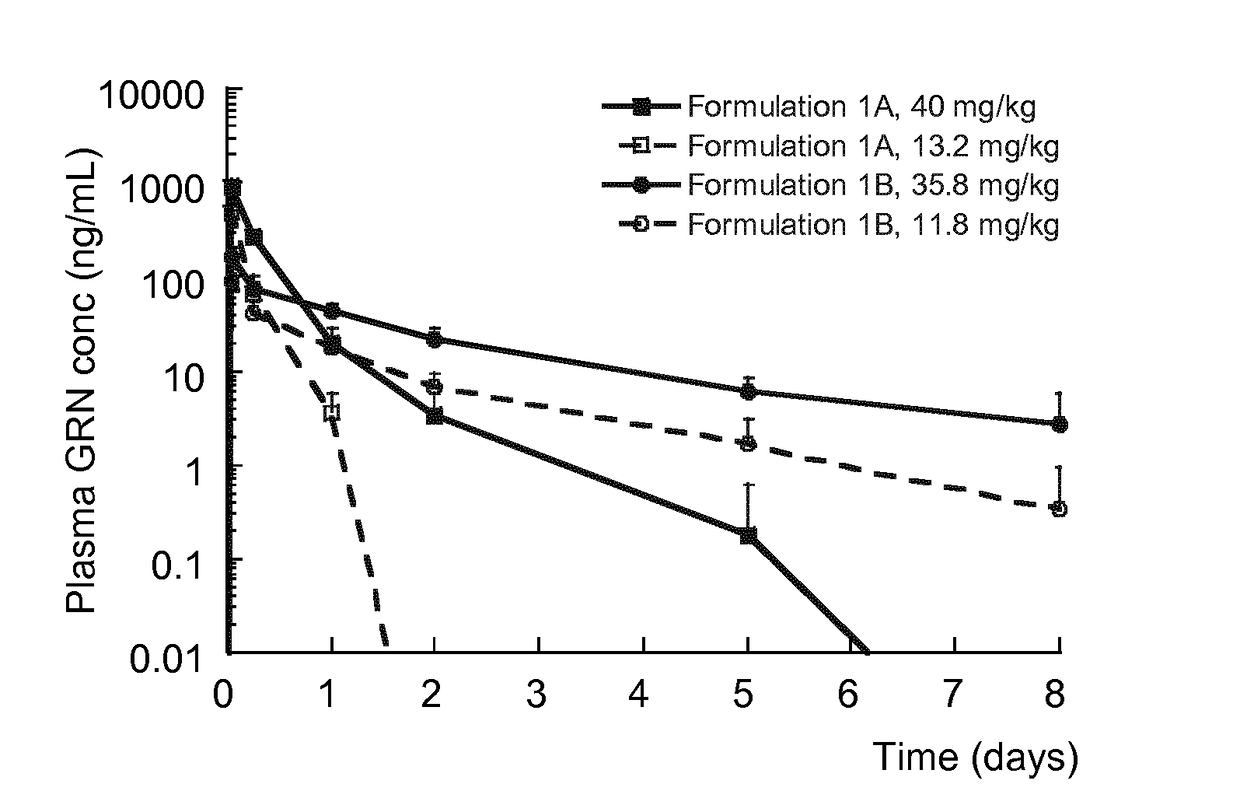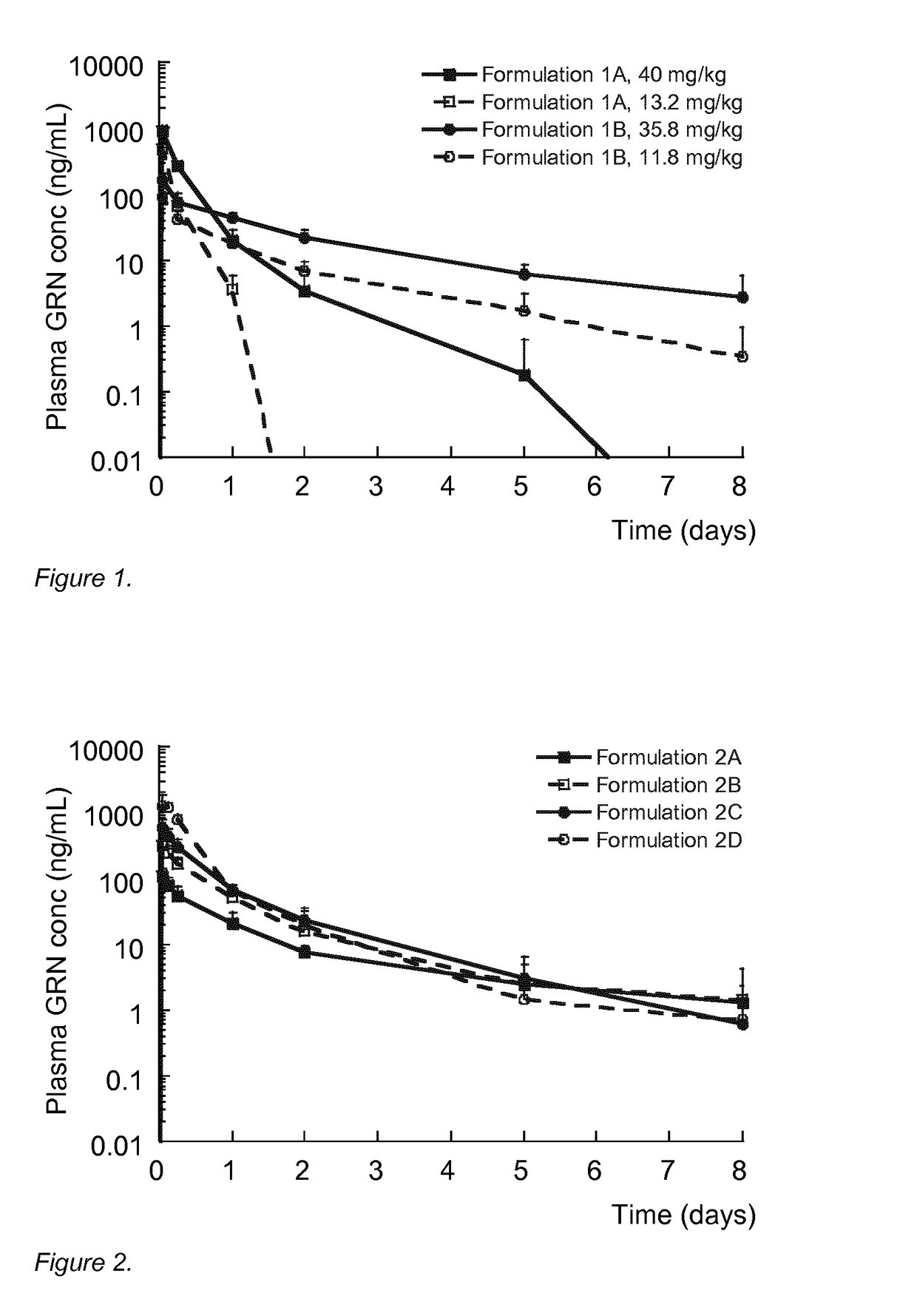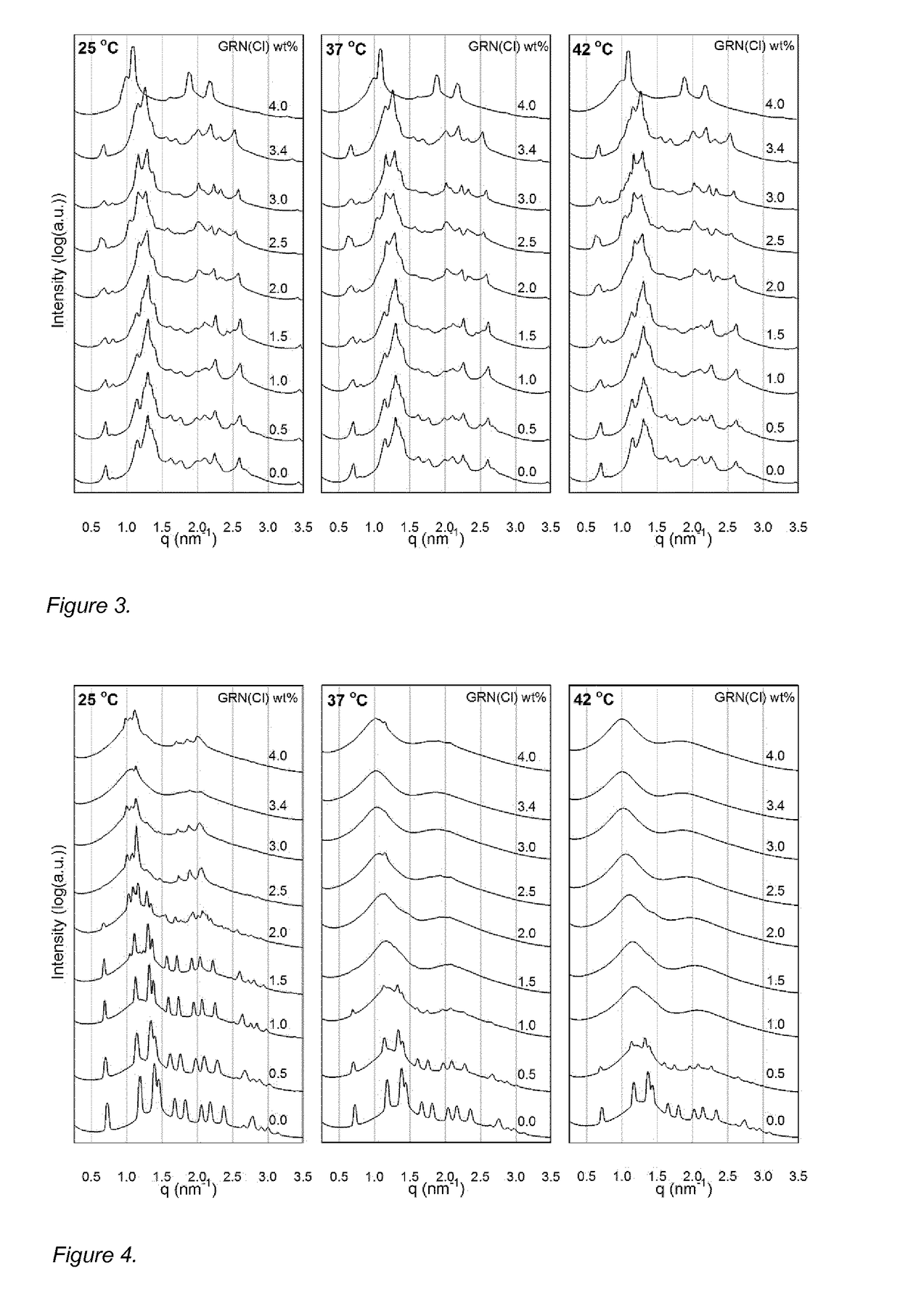Controlled-release formulations
a technology of formulation and controlled release, applied in the direction of pharmaceutical delivery mechanism, organic active ingredients, drug compositions, etc., can solve the problems of unfavorable or even dangerous effects, difficult to achieve, and the area of desired action may not remain accessible for repeated administration, and achieve the effect of low viscosity
- Summary
- Abstract
- Description
- Claims
- Application Information
AI Technical Summary
Benefits of technology
Problems solved by technology
Method used
Image
Examples
example 1
[0168]Pre-formulations (5 g) of granisetron (GRN) and granisetron hydrochloride (GRN(Cl)) were produced by weighing all components (Table 1) in one vial followed by mixing by end-over-end rotation at ambient temperature until clear and homogenous solutions were obtained. The resulting formulations were filtered through sterile 0.22 μm syringe filters under nitrogen pressure.
TABLE 1Formulation compositions (wt %).FormulationGRNGRN(Cl)GDOSPCBzOHEtOHWFI1A4.0—34.234.220.07.6—1B—4.032.632.6—15.815.0Abbreviations:GRN = granisetron;GRN(Cl) = granisetron hydrochloride;GDO = glycerol dioleate;SPC = soy phosphatidylcholine;BzOH = benzyl alcohol;EtOH = ethanol;WFI = water for injection
[0169]The resulting formulations were administered by subcutaneous injection to Sprauge-Dawley rats (n=6 per group) according to Table 2. Blood samples, collected by sub-lingual bleeding, for pharmacokinetic analysis were drawn pre-dose, and then 1 hour, 6 hours, 1 day, 2 days, 5 days, and 8 days after dosing. Th...
example 2
[0171]Pre-formulations (5 g) were produced according to the procedure outlined in Example 1 using granisetron chloride (GRN(Cl)) as the API with water as the polar solvent, having the compositions shown in Table 3.
TABLE 3Formulation compositions (wt %).FormulationGRN (Cl)GDOSPCEtOHWFI2A2.0031.5031.5015.0020.002B4.0030.5030.5015.0020.002C6.0029.5029.5015.0020.002D9.0028.0028.0015.0020.00Abbreviations:GRN (Cl) = granisetron hydrochloride;GDO = glycerol dioleate;SPC = soy phosphatidylcholine;EtOH = ethanol;WFI = water for injection
[0172]Following the procedure described for Example 1, the release duration of granisetron after subcutaneous injection was evaluated in rats using the doses set out in Table 4.
TABLE 4Dosing of pre-formulations comprising GRN (Cl)Dose ofDoseGroupNo ofTreatmentRoute ofGRN (Cl)volumeNoanimals(Formulation)administration(mg / kg)(mL / kg)162As.c.20.01.0262Bs.c.40.01.0362Cs.c.60.01.0462Ds.c.90.01.0
[0173]The results are shown in FIG. 2. All formulations produced granis...
example 3
[0174]Pre-formulations comprising granisetron hydrochloride (GRN(Cl)) were prepared according to the procedure outlined in Example 1, having the compositions shown in Table 5. The formulations had 3.0, 3.5 or 4.0 wt % of GRN(Cl) corresponding to ca 30, 35 or 40 mg / mL of the active ingredient. The formulations were clear and homogenous after mixing and remained as such after long-term storage at room temperature (>1 month). Viscosity measurements of formulations 3A-3D were performed using CAP 2000+ high torque viscometer (Brookfield, Mass.) equipped with CAP01 cone spindle at a share rate rotation speed 300 rpm (500 rpm for 3E formulation) at 20 and 25° C. 75 μl of the formulation was placed between holding plate and cone spindle, equilibrated for 10 s and measured for 15 s. The viscosity results are included in Table 5.
TABLE 5Formulation compositions (wt %) and viscosities.Viscosity (cP)FormulationGRN(Cl)SPCGDOEtOHWFI20° C.25° C.3A3.038.538.510.010.0286.6229.13B3.537.2537.2512.010.0...
PUM
| Property | Measurement | Unit |
|---|---|---|
| total volume | aaaaa | aaaaa |
| total volume | aaaaa | aaaaa |
| total volume | aaaaa | aaaaa |
Abstract
Description
Claims
Application Information
 Login to View More
Login to View More - R&D
- Intellectual Property
- Life Sciences
- Materials
- Tech Scout
- Unparalleled Data Quality
- Higher Quality Content
- 60% Fewer Hallucinations
Browse by: Latest US Patents, China's latest patents, Technical Efficacy Thesaurus, Application Domain, Technology Topic, Popular Technical Reports.
© 2025 PatSnap. All rights reserved.Legal|Privacy policy|Modern Slavery Act Transparency Statement|Sitemap|About US| Contact US: help@patsnap.com



